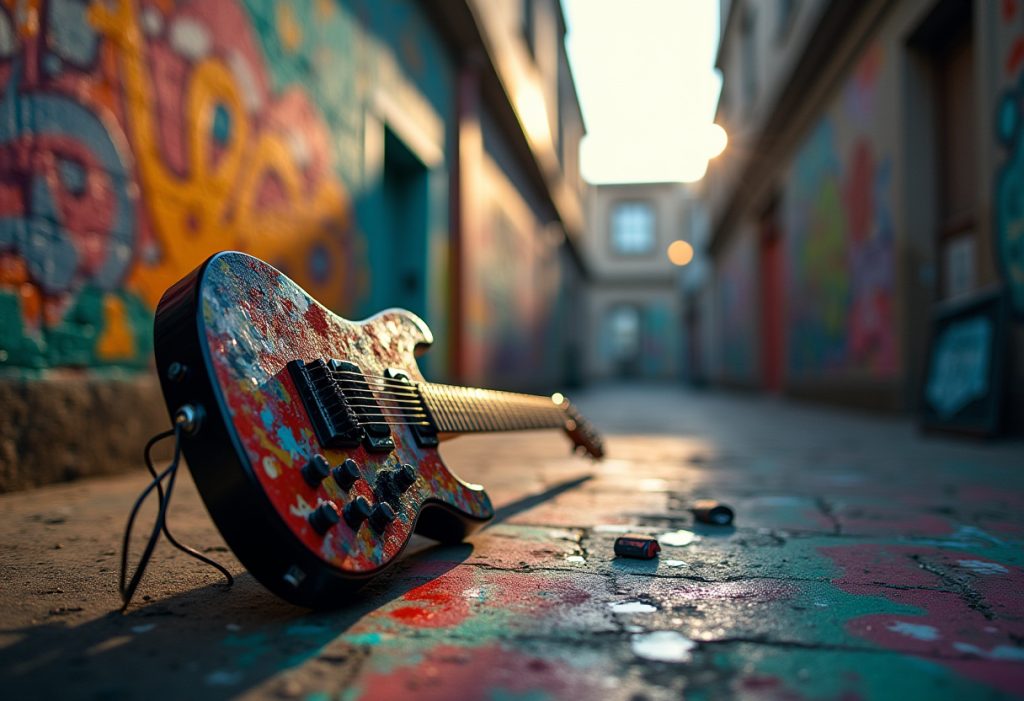Painting a guitar is an exciting way to personalize your instrument and give it a fresh look. Whether you want a classic solid color, a vintage sunburst, or a custom design, painting your guitar can transform its appearance. However, since guitars are made of wood and have delicate finishes, proper preparation and painting techniques are essential to achieving a smooth, professional finish that won’t affect the instrument’s sound quality.

This guide will take you through each step of painting an electric or acoustic guitar, from prepping the surface to applying the final clear coat.
Contents
Choosing the Right Paint for Your Guitar
Types of Paint
Not all paints are suitable for guitars. The best options include:
- Acrylic Lacquer: Fast-drying, durable, and commonly used on guitars.
- Polyurethane Paint: Provides a hard, glossy finish but requires longer curing time.
- Nitrocellulose Lacquer: The traditional choice for vintage guitars, offering a thin, resonant finish.
- Acrylic Paint (for Custom Artwork): Great for designs but needs a strong clear coat to protect it.
Spray Paint vs. Brush-On Paint
- Spray paint: Ensures a smooth, even coat without brush marks. Best for solid colors.
- Brush-on paint: Works well for artistic designs and hand-painted details.
Prepping the Guitar for Painting
Removing the Guitar Hardware
Before you start painting, disassemble the guitar completely:
- Remove the strings, pickguard, bridge, knobs, and pickups (if electric).
- Cover any non-removable parts with painter’s tape to protect them.
Stripping the Old Paint or Finish
- If the guitar has a glossy or thick finish, use sandpaper (220-400 grit) to smooth the surface.
- For thick finishes, apply chemical paint stripper to remove layers efficiently.
- If the guitar has a nitrocellulose finish, avoid harsh chemicals—just sand it down.
Sanding the Surface
- Start with medium-grit sandpaper (220 grit) to remove the glossy finish.
- Use fine-grit sandpaper (400-600 grit) for a smooth surface before painting.
- Wipe away dust with a damp microfiber cloth.
Applying a Primer
A primer helps the paint adhere better and ensures an even coat:
- Spray primer for a smooth finish.
- Apply 2-3 thin coats, allowing each coat to dry for at least 30 minutes.
- Sand lightly with 600-grit sandpaper before applying paint.
Painting the Guitar
Spray Painting Method
- Choose a well-ventilated area (garage or outdoor space).
- Hold the spray can 6-8 inches away and apply light, even coats.
- Let each coat dry for 15-30 minutes before applying the next.
- Repeat the process until you get full coverage (usually 3-5 coats).
Hand-Painted Custom Designs
- Use acrylic paints and fine brushes for custom artwork.
- Work in layers, allowing each color to dry before adding the next.
- Use stencils or tape for sharp lines and geometric patterns.
Creating Unique Guitar Finishes
Solid Color Finish
- Apply multiple thin layers of spray paint.
- Let each coat dry for 30 minutes before reapplying.
Sunburst or Gradient Effect
- Use two or more colors to create a gradient effect.
- Blend colors using light mist coats instead of heavy sprays.
Metallic or Pearl Finish
- Use metallic spray paint for a shimmery, reflective effect.
- Apply a high-gloss clear coat to enhance the shine.
Distressed or Aged Look
- Lightly sand edges and high-contact areas after painting.
- Apply a dark glaze or stain to mimic wear over time.
Applying a Clear Coat for Protection
Why a Clear Coat is Essential
- Protects the paint from scratches, chips, and fading.
- Enhances the depth and gloss of the finish.
- Provides a smooth, professional feel to the guitar body.
Types of Clear Coats
- Glossy lacquer: Creates a high-shine finish.
- Satin or matte lacquer: Provides a softer, muted effect.
- Polyurethane topcoat: Extremely durable but takes longer to dry.
How to Apply a Clear Coat
- Spray light, even coats, holding the can 6-8 inches away.
- Allow each coat to dry for 30-60 minutes.
- Apply 3-5 coats for maximum durability.
- Let the guitar cure for 5-7 days before reassembling.
Reassembling the Guitar
Polishing the Painted Surface
- After the clear coat has dried for several days, use fine polishing compound to buff out any imperfections.
- For a mirror-like shine, use a soft microfiber cloth and buff in circular motions.
Reinstalling Guitar Parts
- Carefully reattach the bridge, pickguard, knobs, and electronics.
- Replace the strings and tune the guitar to standard pitch.
Common Mistakes to Avoid
Skipping the Sanding Step
- Failing to sand the guitar properly can result in paint peeling or uneven coverage.
Applying Thick Paint Coats
- Heavy coats can cause drips and an uneven finish—always use light layers.
Rushing the Drying Process
- Not letting the paint and clear coat cure properly can lead to smudging or dull finishes.
Using the Wrong Paint
- Avoid household paints or cheap acrylics—they may not bond well with the wood.
Final Thoughts
Painting a guitar is a rewarding DIY project that allows you to express your creativity while refreshing an old or worn instrument. Whether you go for a bold solid color, a vintage sunburst, or a custom hand-painted design, following these steps will help you achieve a professional-looking, durable finish.
Would you try painting your guitar? Let us know your dream guitar design in the comments!
